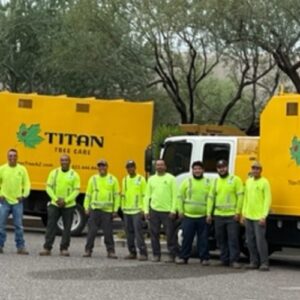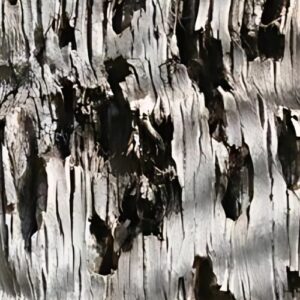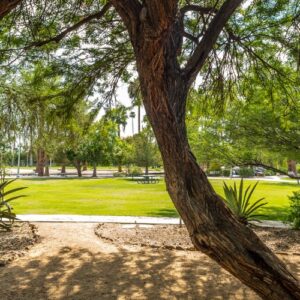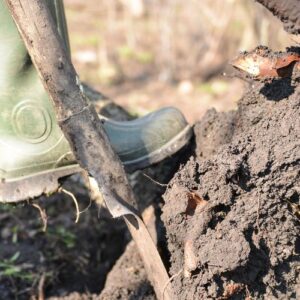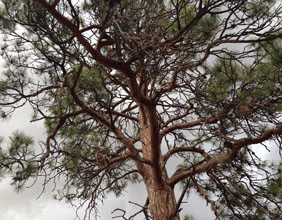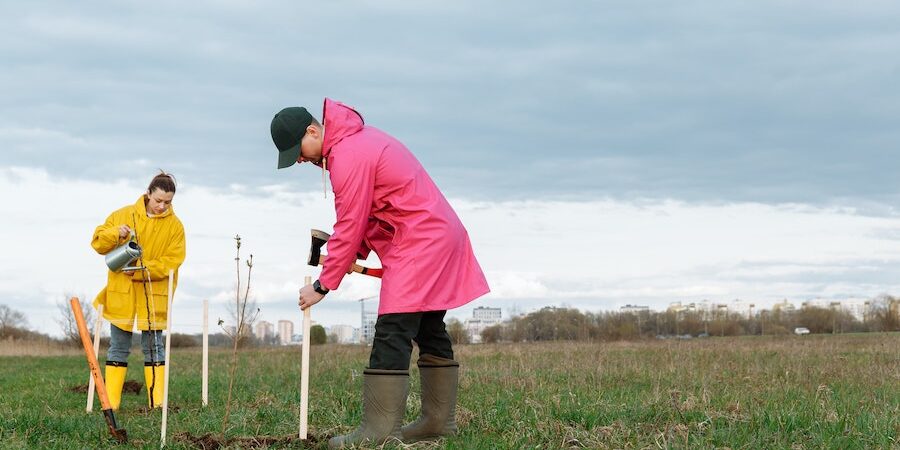
Many people, including plenty of landscapers, plant trees too deep and this almost always results in damage to the tree (in fact, it’s often a fatal mistake). This is easy to remedy if you know what to look for and how to plant correctly.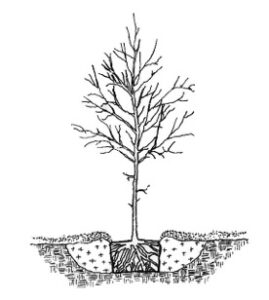
No matter their container size or type, all trees need to be planted at the right depth for their root system. Read on and you can avoid one of the most common tree-planting mistakes.
How deep is too deep when planting a tree?
The measure for tree planting depth is the tree’s root flare. Sometimes called trunk flare or root collar, this is the area just above where the topmost roots emerge from the trunk.
Confusingly, there is not always a flare here, meaning that some trunks, especially on young trees, may look like a straight cylinder. Don’t worry. If you don’t see a flare, look for the tops of roots and for the slight change in surface appearance where the bark tissue ends and root tissue begins.
Unfortunately for homeowners, many trees arrive already planted too deep in containers or burlap wraps, so checking the soil depth around a tree’s trunk is always a good idea. Learning to identify the root flare means that you can ensure your new tree is planted right from the start.
How do I find the root flare?
If your tree arrives having been planted too deep in its container or wrapping, it may be difficult to see the root flare. Locating this area may require gently removing existing planting soil from around the top of the tree’s rootball before planting. This is fine to do, and as long as you are careful you will not damage the tree.
First, you will need to release your tree’s rootball from its container or wrapping. Gently lay the tree on its side, being sure not to damage any branches, and work the container or wrapping off. Do not pull the tree out by its trunk!
Using your fingers or a smooth tool, scrape back the soil from the top of the rootball, untangling and arranging any small roots you disturb. When you have cleared around the circumference of the trunk and exposed the root flare, stand your tree up and measure from the root flare to the base of the rootball. (You don’t want the root system exposed, but just covered by the rootball soil.) This is the maximum depth to plant your tree. Measuring with the tree upright ensures that a loose rootball won’t compress down further after planting.
DIGGING THE PLANTING HOLE
After you’ve located where your tree is going to be planted, dig a round planting hole that is the depth you’ve measured on your tree, and two to three times as wide.
You can use a straight stick or the handle of your shovel to measure by marking the depth with a pencil or a piece of tape: stand your shovel handle up and check that your mark matches the level of the surrounding soil. If your hole is wide, you can lay a straight length of wood across the hole to double check that your shovel handle mark is even with the bottom of the wood piece.
If you’ve dug too deep, add a layer of soil back into the planting hole and compact it with your foot. You want a stable soil base that won’t sink and bring the tree planting level down with it.
INSTALLING THE TREE
Carefully lift your tree into position in the center of your hole (hold it by the rootball as you do this, not by the trunk). Rotate it to make sure the “front” view is right from where you will see the tree. You’ll want to choose the angle that displays the best-looking branch structure.
If your tree doesn’t stand upright on its own, have another person hold the tree steady while you backfill the planting hole around the rootball.
You’ll want to gently pack the backfilled soil with your foot as you fill. You don’t need to stamp hard, you just want to stabilize the backfilled soil so its level doesn’t drop and expose the rootball when you water the tree in.
STAKE IF NEEDED
Tree stakes are commonly used for new trees, but they are not always necessary. If you are staking your tree, follow best practices for tree staking and don’t forget to remove stakes as soon as possible.
WATERING YOUR NEW TREE
In hot and arid climates, it’s always a good idea to shape your backfilled soil with a rounded lip or berm just outside of the rootball. This makes a shallow, dish-like center that encloses the rootball and which will hold water while it percolates into the soil. Providing enough water to new trees is important, as it prevents damage to your tree from heat stress.
After planting and forming a berm, rest the end of a garden hose within the depression and turn water on just to a slow trickle. You don’t want a stream of water that may erode soil and expose roots, just enough for a slow watering that is absorbed into the rootball and the surrounding soil. Leave the water to trickle in for several hours, checking periodically that water is being readily absorbed. If the backfilled soil has sunk below the rootball with watering, replenish the soil so it’s even with the top of the rootball.
MULCH
Add a 3” layer of mulch from the berm outwards, with a 2-3’ diameter. Mulch is vital to help hold water in the soil, regulate soil temperature, and to suppress weed growth. Remember to regularly replenish organic mulch as it breaks down into the soil, and expand your mulch ring as the tree’s crown (and root system) spreads.
WHEN YOU NEED HELP PLANTING A TREE
The information above applies to all trees – planting too deep is a leading cause of tree death. But it’s only practical for a homeowner to plant smaller trees. Larger trees, including those that come in a 24” or larger planting box, are best planted by tree care professionals with the equipment and experience to do it correctly.
Give us a call if you’d like to plant a larger tree on your property. We can recommend the best options, select and deliver the tree, and then plant it properly.
More Articles Like This

Titan Tree Care is a full-service tree care company located in Anthem, AZ and serving all of North Phoenix. We offer a wide range of services to meet your tree care needs, including tree and palm trimming, tree pruning, tree removal, stump grinding, and more. We also offer insect or disease treatments and fertilization services. We are dedicated to providing high-quality, safe, and effective tree care services to our customers and work hard to ensure that your trees are healthy and look their best.




